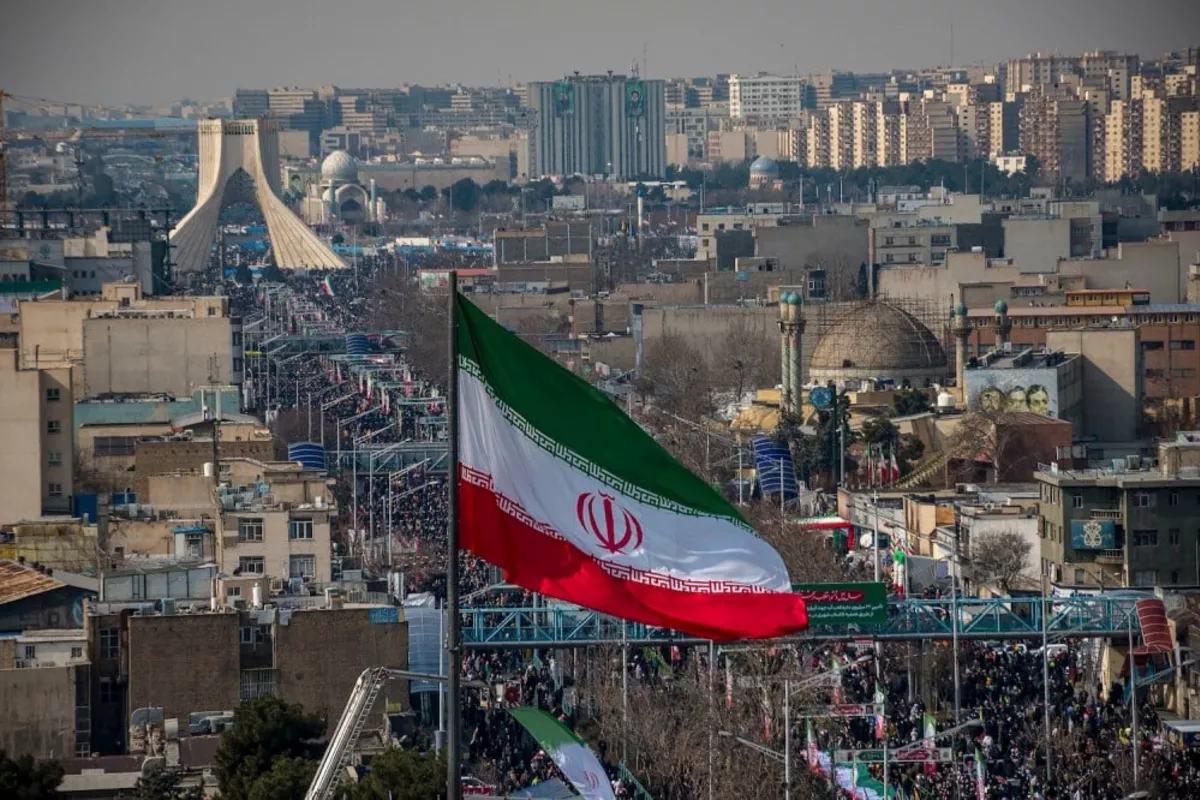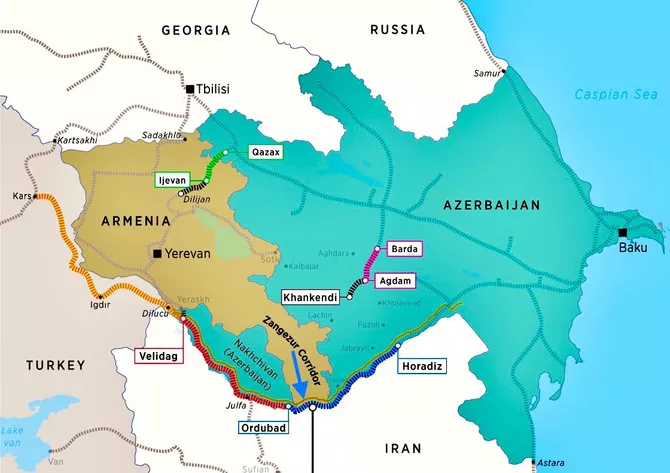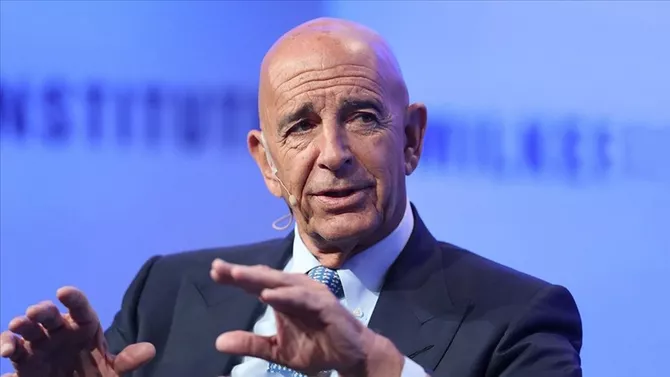
Photo: Informator.az
Throughout its history, the Caucasus has been a target of geopolitical and, above all, military-political expansion. Neighboring states and similar political entities have consistently sought to dominate this strategic region to expand their territorial control and secure access to vital transport and trade routes-many of which converge in the Caucasian isthmus. Traditional trade routes from Europe to Persia and India, as well as the famous Silk Road connecting Europe to China, have passed through this area. Controlling the Caucasus has therefore always promised significant economic and political gains, making it a natural object of interest for various economic and military power centers.
The concept of the “Zangezur Corridor” entered political discourse following the Second Karabakh War in 2020, promoted by Azerbaijani President Ilham Aliyev. This corridor, approximately 32 km long (according to some sources, 49 km), is intended to pass through the southern part of modern-day Armenia-specifically, the Meghri district of the Syunik region-and connect mainland Azerbaijan with its Nakhchivan exclave.

Photo: Caspian Policy Center
For Baku, the corridor represents the shortest and most strategic transport link between the two Azerbaijani territories. Azerbaijan insists on free and unobstructed movement of goods and people through this route, similar to the arrangements that existed during the Soviet period. Baku bases its position on Clause 9 of the trilateral statement signed by Azerbaijan, Armenia, and Russia in November 2020, which calls for the unblocking of all transport and economic links between the countries. Thus, the Zangezur Corridor goes far beyond the scope of Armenian-Azerbaijani relations and has become a subject of interest to numerous regional and global actors.
In the wake of anti-Russian sanctions and shifts in global logistics, the corridor is increasingly viewed by the European Union and Türkiye as an alternative trade route bypassing Russia and Iran. However, Iran strongly opposes the project, fearing the expansion of Turkish-Azerbaijani influence and deeper Western penetration into the region. While formally supporting Armenia's ambiguous position, Tehran sees Zangezur and its border with Armenia as a crucial gateway for its own access to Europe and Russia. Losing this access would deal a severe blow to Iran's geopolitical standing.
Tehran is also deeply concerned about the potential formation of a political and economic union of Turkic states along its borders. The Islamic Republic is already facing the prospect of a growing Arab-Israeli bloc to the west, which threatens to undermine its influence in the Middle East. The rise of a pro-Turkic bloc in the Caucasus could result in Iran's complete marginalization from regional affairs. Thus, the corridor jeopardizes not only Iran's economic interests but also its strategic balance in the region.
Meanwhile, China-the driving force behind the “Belt and Road Initiative”-has shown strong interest in opening new trade routes, including those passing through Iran, Armenia, Georgia, and onward to Europe, as well as alternative routes through Azerbaijan, Armenia, and Türkiye. India also seeks to use the corridor as part of its regional strategy while opposing the Middle Corridor project, where its rivals China and Pakistan play key roles.
The European Union and the United Kingdom view the Zangezur Corridor as a gateway to Central Asia-a resource-rich region with underdeveloped logistics infrastructure. For London, this also revives the long-standing strategic goal of severing Russia's land connectivity with Iran and China-a modern echo of the British “Great Game” in Asia. Türkiye, one of the corridor’s strongest proponents, sees it as a direct economic route into Azerbaijan and further into Central Asia, offering significant transit revenues and increased regional clout.
Russia is likewise interested in maintaining influence in the South Caucasus by controlling the corridor, promoting Eurasian integration, and ensuring regional security. It views participation in the project as a means of preserving its geopolitical presence.
The United States, as a self-proclaimed global hegemon, cannot remain indifferent. During Donald Trump’s presidency, Washington proposed placing the corridor under American control. According to U.S. Ambassador to Türkiye Tom Barrack, who also served as Trump’s special envoy for Syria, the U.S. initiative envisions placing the 32-kilometer route under external administration while building transport, energy, and telecommunications infrastructure.

Photo: Anadolu Agency
This model follows the internationally recognized Build-Operate-Transfer (BOT) scheme. A third-party investor would finance the construction of roads, railways, pipelines, and telecommunications networks and be granted temporary operational rights. Once the investment is recovered, ownership would revert to the Republic of Armenia. Armenian Prime Minister Nikol Pashinyan noted that the model fully aligns with Armenian law. Additionally, there are discussions about transferring customs and border control responsibilities along the corridor to the same private entity, effectively creating a semi-sovereign zone of international administration on Armenian territory.
Despite the absence of a final peace agreement between Yerevan and Baku, Armenia is open to signing an interim deal and continues consultations on the draft of a comprehensive treaty. However, it is precisely Washington’s involvement that has provoked the strongest reaction from Iran. Tehran firmly opposes any format of the corridor that could reshape the South Caucasus geopolitical landscape in favor of the United States.
Iranian officials are fully aware that U.S. strategy aims to establish an “arc of isolation” around the Islamic Republic. Washington’s goals include increasing Iran’s political and logistical isolation and cutting its access to the Caucasus and Central Asia. According to Iranian media, Tehran has taken diplomatic steps to convey its categorical opposition to Moscow, fearing the loss of its strategic partnership with Armenia if the corridor falls under extraterritorial control.
Baku, however, sees Iran’s objections as purely economic in nature. Tehran is pursuing its own corridor along the Iranian bank of the Araz River. In an interview with the Iranian news agency Mehr, infrastructure expert Morteza Naserian expressed concern that a corridor under Baku’s control might ultimately sever Iran’s direct link to Armenia.
Meanwhile, following a meeting with NATO Secretary General Mark Rutte at the White House, Donald Trump stated that the Armenia-Azerbaijan conflict was “approaching successful resolution.” Shortly after, Middle East Eye reported that the U.S. had expressed a desire to take over management of the Zangezur Corridor to advance negotiations between the two countries.
This information was confirmed by Ambassador Tom Barrack, who said the United States “seeks to lease and operate the Zangezur Corridor for 100 years.” Unlike the standard 99-year lease often seen in international deals, the proposed 100-year term strongly signals a bid for permanent U.S. presence in the region.
This prospect is particularly alarming for Iran’s clerical regime, which fears long-term U.S. entrenchment near its northern border-posing a direct threat to Tehran’s regional ambitions and internal stability.
Share on social media